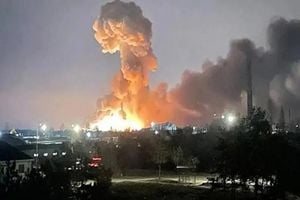The Chaharshanbe Suri festival, an annual celebration marking the last Wednesday before Nowruz, has once again spotlighted the balance between cultural tradition and public safety. On March 19, 2025, Iranian authorities released alarming statistics reflecting the incidents associated with this year's celebrations.
Jafar Miadafar, head of the country's emergency organization, stated that by 10 PM on this day, there had been a staggering total of 1,756 incidents across the nation, leading to severe injuries and fatalities. Among the injured, 100 individuals are reported to have suffered amputations, while 500 experienced eye injuries. Tragically, the events of the night have led to 14 reported deaths. These statistics highlight not only the risks inherent in the celebrations but also the social and emotional consequences carried by the communities involved.
In contrast, Seyyed Sajjad Razavi from the Welfare Ministry reported a significant decrease in injuries compared to the previous year. "We are witnessing a significant decrease in the number of casualties compared to last year," he remarked, emphasizing the proactive measures taken by authorities and the public's adherence to safety protocols. Since the beginning of March, around 1,050 casualties have been reported due to firework-related accidents, indicating a disheartening trend despite a decline in serious incidents.
The discourse surrounding this festival extends beyond the statistics. Cultural critics like Reza Saemi have taken to social media to discuss the psychological narratives tied to such events. In a recent post, Saemi analyzed scenes from the film "Chaharshanbe Suri," where the character Simin experiences an overwhelming sense of insecurity amidst the chaos. He noted, "This sequence illustrates the feeling of insecurity in society; a feeling that many individuals confront, driving them to find solace in precarious situations." This commentary evokes a deeper reflection on how cultural celebrations can mirror the psychological states of individuals within society, particularly in times fraught with danger.
The Chaharshanbe Suri festival is not merely a night of fireworks; it is steeped in tradition yet riddled with risks. The juxtaposition of joy and danger during these celebrations raises essential questions about safety and the cultural practices interwoven with identity. While the symbolic act of jumping over fire is intended to cleanse and bring joy, it also unveils how social anxieties manifest through the communal experience, much like depicted in contemporary cinema.
As communities reflect on the implications of the recent events, health officials have reiterated the importance of adhering to safety protocols during these celebrations. Razavi further urged, "People should be mindful of the use of fireworks and follow safety guidelines to prevent lifelong regrets caused by mishaps during these traditional celebrations." He also pointed out that the majority of injuries arise from improperly handling fireworks, which leads to devastating consequences.
Engagement with cultural practices, such as Chaharshanbe Suri, inherently carries a dual edge—offering a chance for community bonding while also posing significant risks. As injury statistics roll in and critics delve into the psychological narratives of the festival, it is crucial for individuals to balance tradition with the need for safety.
The trauma incurred during events like Chaharshanbe Suri challenges the community to rethink its relationship with cultural festivities. The efforts of health authorities and cultural critics alike serve as critical reminders of the intertwining of joy, anxiety, and responsibility. Public perception must evolve to embrace a celebratory spirit while confronting the stark realities that accompany such exuberance.
As the season turns towards Nowruz, the hope remains that the lessons learned from this year's Chaharshanbe Suri will lead to decreased incidents in future celebrations, reinforcing the notion that safety can coexist with tradition. With both cultural acknowledgment and prepared healthcare systems, there can be a sustainable celebration that honors history without jeopardizing the lives of participants.






